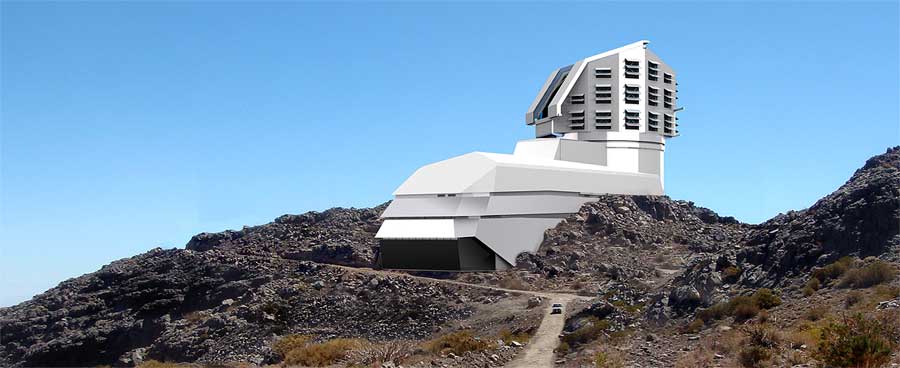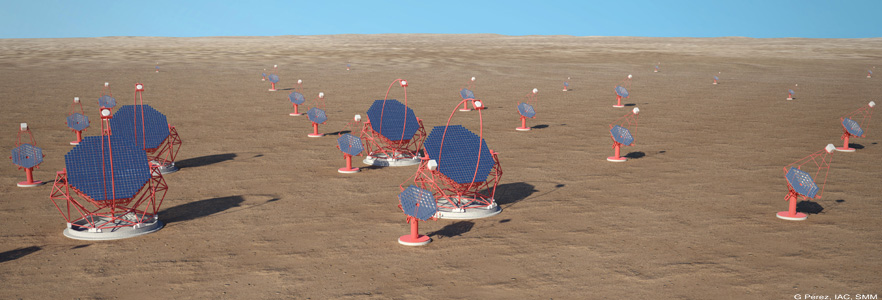PRESENTATIONS FROM THIS MEETING ARE AVAILABLE HERE.
Researchers in transient and time domain astronomy are invited to attend a Royal Astronomical Society (RAS) Specialist Discussion Meeting in London on Friday, 14 November. The discussion will focus on astronomy and astrophysics with the Liverpool Telescope and Liverpool Telescope 2. The aims of the meeting are to showcase the many varied programmes that are active on the Liverpool Telescope, to stimulate new collaborations and ideas, and to engage with the community regarding our plans for the future.
 An artists impression of what the Large Synoptic Survey Telescope (LSST) will
look like on Cerro Pachon in Chile. Image courtesy NOAO.
An artists impression of what the Large Synoptic Survey Telescope (LSST) will
look like on Cerro Pachon in Chile. Image courtesy NOAO.
The robotic 2m Liverpool Telescope, based on the Canary Island of La Palma, is owned and operated by Liverpool John Moores University, with operational support from STFC. It has a strong track record of service to the time domain community in the UK and beyond. The next decade will see time domain science becoming an increasingly prominent part of the astronomical agenda, and the LT will continue to be at the forefront, with large programmes exploiting new transient sources discovered with facilities such as iPTF, Gaia and LOFAR.
Looking further into the future, the next generation of surveys such as LSST will revolutionise the study of the time variable sky, and facilities such as CTA will probe transient phenomena at previously unexplored wavelengths. New exoplanet finders, starting with NGTS and followed by the next generation of space missions, will improve on the Kepler Space Telescope's efforts by discovering more planets orbiting bright host stars in order to maximise the potential of ground based follow-up. In addition, the anticipated discoveries of electromagnetic counterparts to astrophysical gravitational wave and neutrino sources will open new windows on the transient universe.
There will be a pressing need for follow-up facilities for scientific exploitation, in particular spectroscopic follow-up. With that in mind, plans are underway for Liverpool Telescope 2, a new 4-metre robotic telescope to be built on La Palma, with a world-leading response time for follow-up of the most rapidly varying objects.
 The Cherenkov Telescope Array (CTA) will be a new facility for
ground-based gamma-ray astronomy in the energy regime from 10 GeV
to a few hundred TeV. Image courtesy University of Heidelberg.
The Cherenkov Telescope Array (CTA) will be a new facility for
ground-based gamma-ray astronomy in the energy regime from 10 GeV
to a few hundred TeV. Image courtesy University of Heidelberg.
An overview of the current status of the Liverpool Telescope 2 project is provided in a recent SPIE article (Copperwheat et al. 2014). A detailed science white paper will also shortly be made available on the astrophysics archive and on the LT2 website. In the meeting we will discuss the scientific role for LT2, focusing largely (though not exclusively) on the objectives outlined in these documents. We will also discuss the instrumental requirements for LT2, as well as potential enhancements to LT to enable it to remain relevant in the 2020 time domain landscape.
Time and location of the meeting
The meeting will be held at the Royal Astronomical Society, Burlington House, London, on 14 November, 2014. A more detailed agenda of talks will be circulated in due course.
Registration and abstracts
Attendance at this meeting is free for members of the RAS. For non-members there will be an attendance fee of £15 (£5 for students) to be paid at the door. The deadline for the submission of abstracts is 7 October 2014. Abstracts should be sent to Chris Copperwheat (c.m.copperwheat "at" ljmu.ac.uk) or Chris Davis (c.j.davis "at" ljmu.ac.uk).
Science Organising Committee:
Mike Bode, Chris Copperwheat, Chris Davis & Iain Steele
For further information on the Liverpool Telescope 2 project, please visit the LT2 web-site.


